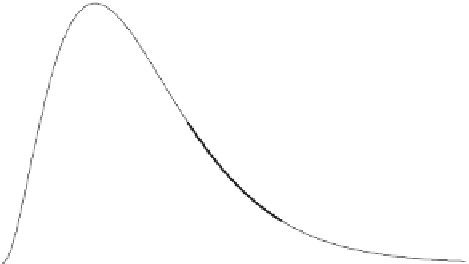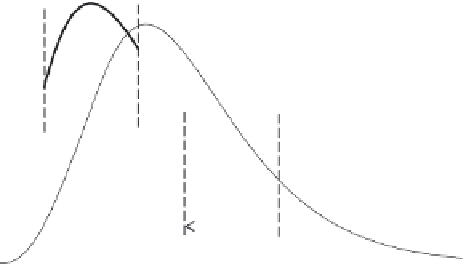Geoscience Reference
In-Depth Information
0.3
A
y
UH
D
0.2
C
(cm h
−
1
)
E
0.1
B
D
u
IUH
F
0
0
5
10
t(h)
Fig. 12.7 Relationship between the 2 h unit hydrograph of Example 12.1 (UH) and the corresponding
instantaneous unit hydrograph (IUH) for the same catchment. For example, the ordinates of the UH at
points A and B are, respectively, the averages of the segments CD and EF on the IUH, in accordance
with Equation (12.5).
illustrated in Figure 12.7. Because of this one-to-one relationship between the finite
duration unit hydrograph and the instantaneous unit hydrograph, no distinction need be
made between the two, and both can be referred to as unit response function.
The instantaneous unit hydrograph can also be used to derive the S hydrograph by
simply applying Equation (12.2) with a constant unit input rate,
x
(
t
)
=
1
.
00, starting at
t
=
0, that is a unit step function as defined in Equation (A8), or
t
S
u
(
t
)
=
u
(
t
−
τ
)
d
τ
(12.6)
0
Note that [
x
(
t
)
T]. Application of Leibniz's
rule (A2) shows readily that the instantaneous unit hydrograph is the slope of the S
hydrograph. Actually this also follows directly from Equation (12.1), as can be seen by
letting the unit duration
D
u
approach zero, or in the limit as
D
u
→
=
1
.
00]
=
[L
/
T], so that also [
S
u
(
t
)]
=
[L
/
0
dS
u
(
t
)
dt
u
(
t
)
=
(12.7)
12.2
IDENTIFICATION OF LINEAR RESPONSE FUNCTIONS
12.2.1
From available data
Simple storm events
In principle, it should be relatively straightforward to determine the unit hydrograph,
whenever the rainfall occurs as a single burst of acceptably uniform intensity and of a
suitable duration, and is accompanied by an easily identifiable streamflow hydrograph.
This may be done by first subtracting the baseflow from the observed hydrograph and by




























































